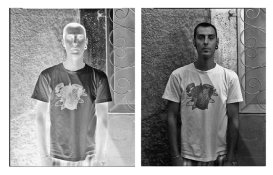Robert Kalman
Member
Somehow, I seem to be damaging some of my 4x5 negatives during processing. Below is example of what is happening. Note the diagonal line running from the upper left to the lower right.
I process the film in the following manner:
> 15 negatives in an open tray.
> Presoak in plain water
> 3 minutes, 15 seconds in HC-110B. Tray is rocked continually.
> Plain water stop bath. Kodak rapid fix for 3 minutes. Washed, permawashed, washed. (By the fixing step, the damage is already discernable; so it must be happening during development).
Some assumptions I've already gone through:
> Negatives are sticking to one another during development: Possible, but unlikely, since I'm careful to thoroughly soak and separate the negatives during the pre-soak, and when I introduce the negatives into the developer I carefully shuffle through them to make sure they are separated.
> The problem may be created during the few seconds the negatives are transferred from the developer to the stop bath and then transferred to the fixer: When development time is done, I quickly gather the negatives and place them into the plain water stop bath. Then I quickly tranfer them one at a time into the fixer. It is during this stage that the negatives are momentarily lying on top of one another without agitation.
> I'm thinking that I may be processing too many negatives at once, and that, even with constant agitation some negatives are touching one another just long enough to introduce an interruption during development. But, I frequently process 15 negatives at once without any problems.
Then again, I'm wondering if the problem is somehow related to film handling, and that it's not a processing problem at all.
Does anyone have a suggestion as to what may be causing the damage, or at what stage in the process this is likely to be happening, or if it's something I'm doing during film handling?
Many, many thanks.
Bob Kalman
I process the film in the following manner:
> 15 negatives in an open tray.
> Presoak in plain water
> 3 minutes, 15 seconds in HC-110B. Tray is rocked continually.
> Plain water stop bath. Kodak rapid fix for 3 minutes. Washed, permawashed, washed. (By the fixing step, the damage is already discernable; so it must be happening during development).
Some assumptions I've already gone through:
> Negatives are sticking to one another during development: Possible, but unlikely, since I'm careful to thoroughly soak and separate the negatives during the pre-soak, and when I introduce the negatives into the developer I carefully shuffle through them to make sure they are separated.
> The problem may be created during the few seconds the negatives are transferred from the developer to the stop bath and then transferred to the fixer: When development time is done, I quickly gather the negatives and place them into the plain water stop bath. Then I quickly tranfer them one at a time into the fixer. It is during this stage that the negatives are momentarily lying on top of one another without agitation.
> I'm thinking that I may be processing too many negatives at once, and that, even with constant agitation some negatives are touching one another just long enough to introduce an interruption during development. But, I frequently process 15 negatives at once without any problems.
Then again, I'm wondering if the problem is somehow related to film handling, and that it's not a processing problem at all.
Does anyone have a suggestion as to what may be causing the damage, or at what stage in the process this is likely to be happening, or if it's something I'm doing during film handling?
Many, many thanks.
Bob Kalman












